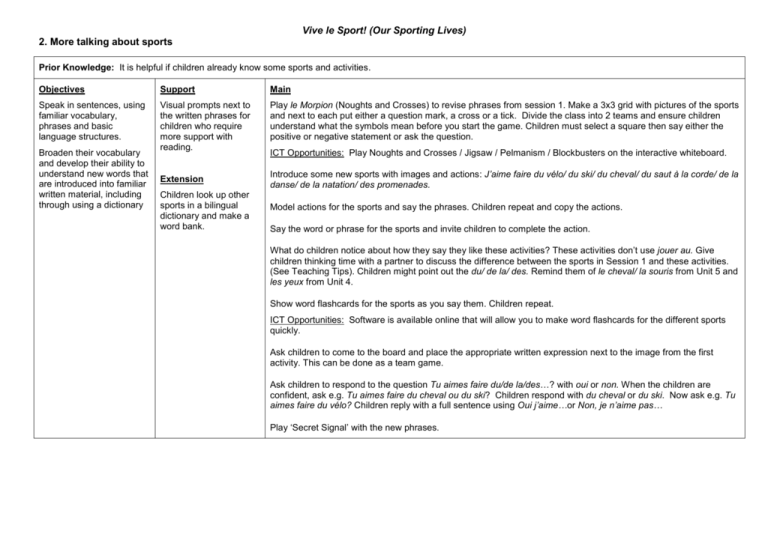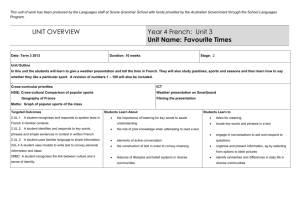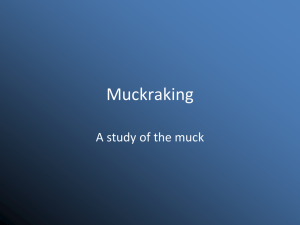Year 4 Unit 10 Vive le Sport Session 2_French
advertisement

Vive le Sport! (Our Sporting Lives) 2. More talking about sports Prior Knowledge: It is helpful if children already know some sports and activities. Objectives Support Main Speak in sentences, using familiar vocabulary, phrases and basic language structures. Visual prompts next to the written phrases for children who require more support with reading. Play le Morpion (Noughts and Crosses) to revise phrases from session 1. Make a 3x3 grid with pictures of the sports and next to each put either a question mark, a cross or a tick. Divide the class into 2 teams and ensure children understand what the symbols mean before you start the game. Children must select a square then say either the positive or negative statement or ask the question. Broaden their vocabulary and develop their ability to understand new words that are introduced into familiar written material, including through using a dictionary ICT Opportunities: Play Noughts and Crosses / Jigsaw / Pelmanism / Blockbusters on the interactive whiteboard. Extension Introduce some new sports with images and actions: J’aime faire du vélo/ du ski/ du cheval/ du saut à la corde/ de la danse/ de la natation/ des promenades. Children look up other sports in a bilingual dictionary and make a word bank. Model actions for the sports and say the phrases. Children repeat and copy the actions. Say the word or phrase for the sports and invite children to complete the action. What do children notice about how they say they like these activities? These activities don’t use jouer au. Give children thinking time with a partner to discuss the difference between the sports in Session 1 and these activities. (See Teaching Tips). Children might point out the du/ de la/ des. Remind them of le cheval/ la souris from Unit 5 and les yeux from Unit 4. Show word flashcards for the sports as you say them. Children repeat. ICT Opportunities: Software is available online that will allow you to make word flashcards for the different sports quickly. Ask children to come to the board and place the appropriate written expression next to the image from the first activity. This can be done as a team game. Ask children to respond to the question Tu aimes faire du/de la/des…? with oui or non. When the children are confident, ask e.g. Tu aimes faire du cheval ou du ski? Children respond with du cheval or du ski. Now ask e.g. Tu aimes faire du vélo? Children reply with a full sentence using Oui j’aime…or Non, je n’aime pas… Play ‘Secret Signal’ with the new phrases. Vive le Sport! (Our Sporting Lives) 2. More talking about sports Grammar Grammar Phonics focus Phonics focus For teachers: For children: For teachers: For children: Verbs – as with Lesson 1 of Unit 10, two verbs are used in the same sentence and both relate to the same subject, so only the first will be conjugated; the second will be used in the infinitive form, e.g. I like horse-riding / I like to go horse-riding – j’aime faire du cheval. Asking questions – remind pupils of the rising intonation, which indicates a question in the examples above: tu aimes faire du vélo? [y] u – du [ɛ] ai – aime, faire Prepositions – there are three different ways of using de after faire, when used with sports and activities. Here, as with the preposition à in Lesson 1, de changes according to what follows. Negatives – je n’aime pas faire du ski etc. Remind children that using ne … pas around the verb makes it negative. The ne loses its e when the following verb starts with a vowel (n’aime) [ʃ] ch – cheval When de is followed by the masculine definite article (le) it contracts into a single word: du. Instead of writing or saying j’aime faire de le ski, the de + le join together to give du. When followed by the feminine definite article (la) the de and the la remain separate – j’aime faire de la danse. When followed by the plural definite article (masculine or feminine – les) the de and the les join together to give des, e.g. j’aime faire des promenades. Faire – it is worth noting that the verb faire can be difficult for children to get used to. As well as meaning ‘to do’ or ‘to make’, it can also convey ‘to go’, e.g. faire des promenades would be translated as ‘to go for walks’ rather than ‘to do walks’. Learning Outcomes New National Curriculum Links Children can: No specific links Understand the phrases for different sports in French Recognise some of these phrases in written form [e] é – vélo [sjɔ̃] tion - natation [i] i – ski [a] a – cheval, natation, promenades Silent final consonant – des, promenades, saut [o] au – saut [ɑ̃] an – danse [u] ou - jouer Throughout the week: Resources Play the ‘Chain Game’. One child asks their neighbour if they like a certain sport. That child replies and then asks another and so on. The aim is to get right round the class with no breaks in the question and answer chain. Morpion grid Images of different sports Teaching Tips Cards with written phrases (Props – football, tennis racket etc.) When introducing sports, it is a good idea to teach the phrases that use faire separately from those with jouer (see Session 1). Use props to introduce the sports, such as a cycle helmet, football etc. Using an action for each sport can also help some children remember the new vocabulary. Add picture symbols of sports to the word flashcards, to support less confident readers. The interactive whiteboard may be used to present the language and play team games. Vive le Sport! (Our Sporting Lives) 2. More talking about sports Set the rules for the team game so that children lose a point for shouting out. It is worth spending some time establishing the correct pronunciation of the –tion sound in French before the children see it written down, as it is different from the equivalent in English (which often produces more of a ‘shun’ sound). When playing noughts and crosses, encourage children to start using French for the directional language of the game to express their wishes, e.g. en haut (at the top), en bas (at the bottom), au milieu (in the middle), à gauche (on the left), à droite (on the right). Le langage du prof Teacher Language Le langage des enfants Children’s Language Écoutez et répétez Listen and repeat Tu aimes…? Do you like…? ou or Tu aimes…? Do you like…? J’aime I like ou or Je n’aime pas I don’t like J’aime I like Je préfère I prefer Je n’aime pas I don’t like Je préfère I prefer faire du vélo / du ski / du cheval / du saut à la corde to go cycling / skiing / horse-riding / skipping faire du vélo / du ski / du cheval / du saut à la corde to go cycling / skiing / horse-riding / skipping faire de la danse / de la natation to go dancing / swimming faire des promenades to go for walks faire de la danse / de la natation to go dancing / swimming faire des promenades to go for walks





